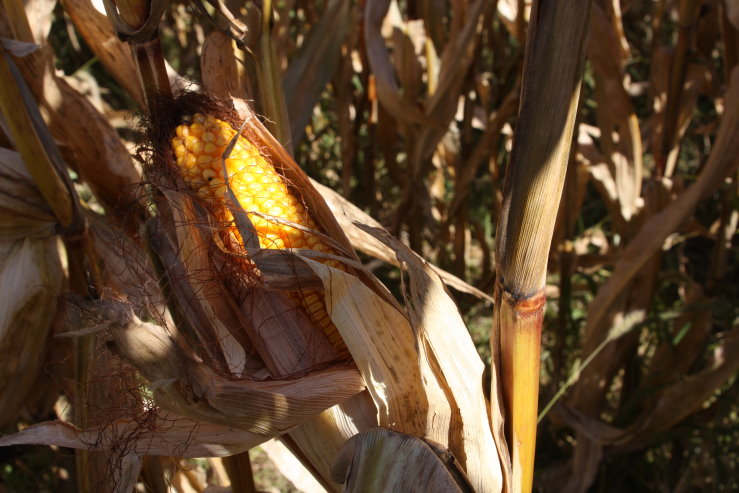
Agricultural News
Tightest Corn Supplies Seen in 16 Years According to Latest USDA Data
Mon, 12 Sep 2011 16:28:57 CDT
 A late-summer heat wave cut the U.S. corn crop by 3 percent, said the government on Monday, equal to trade expectations, but it boosted its forecast of the soybean crop by 1 percent due to higher yields. The smaller corn crop will mean less grain for livestock feeders and ethanol makers and the tightest corn supply in 16 years, said the Agriculture Department. Corn for ethanol would drop by 2 percent and corn for feed by 4 percent in the coming year. We have initial reaction from Tom Leffler- our own Ed Richards spoke with Tom this morning and you can hear their conversation by clicking on the LISTEN BAR at the bottom of this story.
A late-summer heat wave cut the U.S. corn crop by 3 percent, said the government on Monday, equal to trade expectations, but it boosted its forecast of the soybean crop by 1 percent due to higher yields. The smaller corn crop will mean less grain for livestock feeders and ethanol makers and the tightest corn supply in 16 years, said the Agriculture Department. Corn for ethanol would drop by 2 percent and corn for feed by 4 percent in the coming year. We have initial reaction from Tom Leffler- our own Ed Richards spoke with Tom this morning and you can hear their conversation by clicking on the LISTEN BAR at the bottom of this story.
With the harvest season opening, the Agriculture Department estimated the corn crop at 12.497 billion bushels, the third-largest crop on record but down 3 percent from its August forecast. Yields are down across most of the Corn Belt due to unusually hot and dry weather in late August. Corn would average 148.1 bushels an acre this fall, the lowest U.S. yield since 2005, and down 4.9 bushels from the August estimate.
The soybean crop was forecast for 3.085 billion bushels, up 1 percent due to higher yields although USDA ratings of the crop condition declined during August. Traders expected USDA to cut the crop by 1 percent. The soybean stockpile would shrink to 165 million bushels by next fall, slightly larger than traders expect but a two-and-a-half week supply. Corn supplies were forecast for 672 million bushels next Sept 1, compared to trade expectations of 636 million bushels. It would be a lean stocks to use ratio of 5.3 percent.
With a slightly larger domestic cotton crop, China will import 14.5 million bales of cotton during 2011/12, down 500,000 bales from last month's estimate, said USDA. It cut its forecast of U.S. cotton exports by 300,000 bales, to 12 million bales for this marketing year. The US Cotton crop forecast was left virutally unchanged at 15.819 million bales of upland cotton, which is just over ten percent smaller than the 2010 crop.
The Oklahoma spring planted crop numbers showed little change from the August estimates, with only peanuts set to produce a similar sized crop to 2010. The Oklahoma peanut harvest is predicted to bring in 69 million pounds, 2.6% more than the 2010 crop. In contrast, the Oklahoma cotton crop, which had been trending upward over the last few years, is called to be 79% smaller than in 2010. The 90,000 bales is up 5,000 bales from the August forecast- but just a fraction of the 422,000 bales grown in 2010.
Grain sorghum production in the state has fallen 79% compared to 2010, the soybean crop is 60% smaller than last year and the corn crop has shrunk by 50% in 2011 versus 2010.
Click here for the complete USDA Crop Production Numbers released this morning from NASS, data that is based on September first surveys.
In addition, the monthly Supply Demand numbers have been released from the World Ag Outlook Board and the USDA Economic Research Service. You can view that complete report by clicking here.
Looking briefly at the major crops and the supply demand data-
Corn: USDA reduced total use by 400 million bushels, to 12.76 billion bushels. The economists trimmed 200 mb from feed and residual, 100 mb from ethanol, and 100 mb from exports. Carryout dropped to 672 million from August's 714 mb. The stocks-to-use ratio is 5.3%, only a touch above the record low of 5.0%. The estimated average price rose from $6.70 to $7.
Soybeans: Looking at soybean usage, crush was left unchanged, exports and residual use rose, and seed fell. Resulting ending stocks were pegged at 165 mb, up 10 million from August, but still 60 mb below old-crop ending stocks. Ending stocks-to-use is 5.2%, a level that the market is generally comfortable with. The average price estimate rose modestly from $13.50 in August to $13.65.
Wheat: Counter to expectations, all-wheat ending stocks rose to 761 million bushels from August's 671 mb, 33% of expected total use. USDA reduced exports 75 mb and food use 5 mb; left feed and residual use unchanged from August, at 240 mb, versus 133 for the 2010-11 crop year. USDA raised its average price estimate form $7.60 in August to $7.85.
WebReadyTM Powered by WireReady® NSI
Top Agricultural News
More Headlines...



















